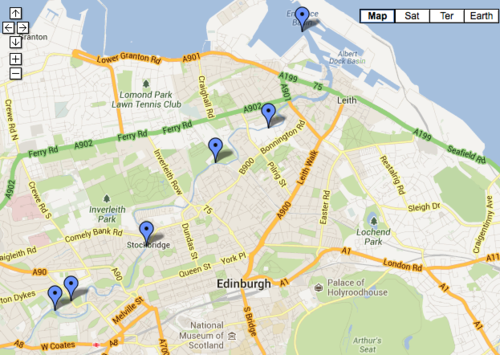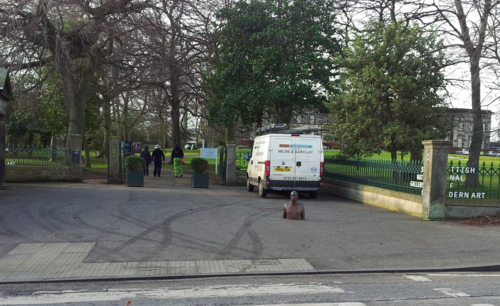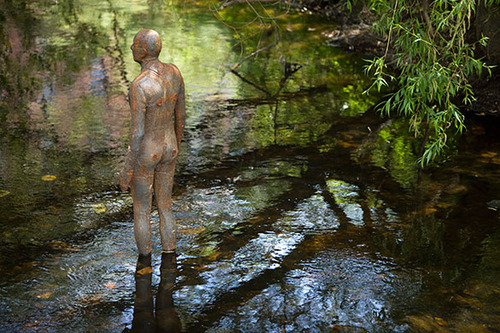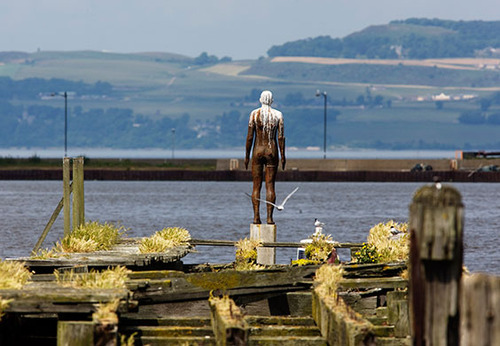
6 Times by Antony Gormley and the Water of Leith Walkway, Dunedin or Edinburgh
Walk along the Water of Leith in Dunedin (also known as Edinburgh), following the ancient windy river from the Scottish National Gallery of Modern Art to the ocean, and you’ll come across a rusty brown chap in the middle of the river. He’s naked and utterly alone in the water. Nondescript body, expressionless face, hands turned inward as if in midstride. We know he is a man because there’s something like a penis, but then again, he also has bolts for nipples.

Strolling towards freedom, or at least the ocean. Photo by Murdo MacLeod.
Not long after, you will bump into another lonely naked figure standing in the river. Then another and another. In total there are six almost identical sculptures along the 12 miles (20 km) Water of Leith walk.
They look identical because they pretty much are. Antony Gormley has cast these, and hundreds of others across the world, from a small number of molds of his own body. He does industrial art. Its a bit like those little figurines of old wise man or Buddhas you buy in Chinatown, or almost anywhere else in the world. Often sold as handmade artisanal pieces from far away places, they are manufactured in factories across Asia.
Gormley’s manufacturing of cast selfies has stirred some controversy. He is nonetheless one of the most popular artists in the UK, and keeps winning awards, and raking in the money.
Where’s the art in all this you ask?

Stuck in the city with square nipples. Cast-iron and lots of asphalt. Photo by Pepe Houtzager.
There’s a clue in cast No.1 of 6, the starting point of the Water of Leigh walk. He is waist deep in the driveway of the Scottish National Gallery of Modern Art. Skid marks run perilously close to this Gormley, and its easy to imagine a drunk or disgruntled citizen taking aim. We are told he is identical to the other casts and has a full body buried underground.
The art is in the placement of No.1. He is stuck and vulnerable. Instead of raised up on a plinth he’s sunk down into the ground. A bloody driveway no less. Its shocking. I felt sorry for No.1, being stuck and all, and worried he was going to get hit by a passing vehicle. The expressionless face gives him an indifference that I admire. He’s doing his thing no matter what. And showing no visible signs of hardship.
Still, the guy is trapped. That’s not good no matter how he’s taking it.
Along the river things get greener and better.
Casts no.2-5 feel completely different from No.1, although physically they are identical, except for difference in rust, bird poop, and other natural forces that erode cast-iron. Placement is the art, and it transforms our feelings for the figures.

Awe, look at his little butt. Its English. Photo by Murdo MacLeod.
The journey along the river is a journey towards freedom, an open view of the ocean. Freedom, however, is not without its problems.

Iron cast no.6, seagull, and the Dock of Leigh. Photo by Murdo MacLeod.
All credit to the artist though. Gormley is all about his sculpture changing over time as they rust, get chipped away by river debris, and shat on by wily seagulls. All this is endured by casts 1 thru 6 in solitude, with indifference, and anonymously.
Gormley is so committed to non-signalling what you’re supposed to feel or think about all this that he even refused to name his figures. One alarmed resident of Edinburgh called the police, convinced that a man had hung himself from Dean Bridge, which spans the river. The police found a nondescript rusty poor sod standing smack in the middle of the Water of Leith.
That’s art. It’s the figures unexpectedness presence and shapeless anonymity that gets to people.
Water of Leith Walkway is protected by the Water of Leith Conservation Trust. It runs though several villages, including Dean Village which is 800 years old. The walk also goes through Colinton Village and Dell, the Union Canal, Saughton Winter Gardens, Murrayfield Stadium, Stockbridge, the Royal Botanic Garden, and finally, the Leith dock. If you are in Edinburgh don’t miss it.
Sources
- http://www.scotsman.com/news/art-review-antony-gormley-6-times-1-813906
- Art review: Antony Gormley: 6 times
- Antony Gormley: Making Space, Beeban Kidron documentary. 2007.
- http://www.guardian.co.uk/artanddesign/2007/sep/08/art11
- Charlotte Higgins, Antony Gormley, Turner prize winner 1994,









